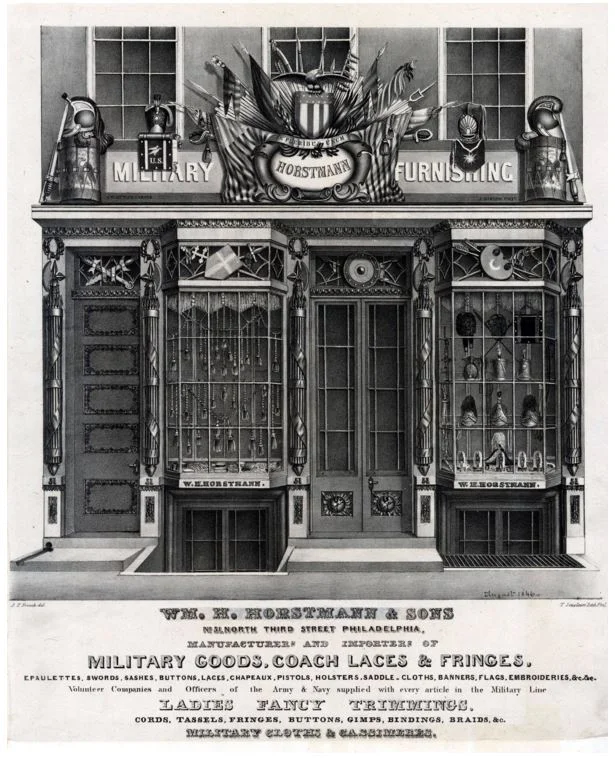38 Star Antique Flag with a Tremendous Medallion Pattern | Circa 1876-1889
38 Star Antique Flag with a Tremendous Medallion Pattern | Circa 1876-1889
Frame Size (H x L): 27” x 37”
Flag Size (H x L): 17” x 27”
Offered is a thirty-eight star parade flag with a tremendous medallion pattern. The medallion includes a center star, an inner ring, a middle ring, and an outer ring. The outer ring is surrounded by four flanking stars, one of which is in each corner of the canton. The star in the center and the stars in the rings are all identical in size, and likewise the four flanking stars are identical in size. Most medallions include a large center star and smaller stars surrounding it, but this medallion, in contrast, is made of smaller stars in the center, and larger flanking stars. The result is an unusual medallion that presents wonderfully.
This flag was likely made by Horstmann & Sons, later known as Horstmann Brothers, based on the fact that a group of similar flags was discovered, in which one was marked Horstmann along the hoist. As shown in the advertisement above, Horstmann Brothers offered a number of military and patriotic items—including swords, pistols, saddles, banners, and flags—and is a well-known manufacturer among Civil War collectors.
This flag is made of wool, and was made by a process known as press dyeing. Shown in the images above is an early press dyeing patent, issued in 1849. Several other patents issued in the 19th century for similar, improved processes. The invention described in the 1849 patent included using a dye vat in combination with a dyeing frame. The dyeing frame was made, so as to prevent the dye from penetrating portions of the flag that did not need any color (e.g., the stars and/or white stripes). Press dyeing never gained widespread use, as it tended to result in minor printing blemishes. For example, the stars of this flag exhibit bleeds of blue, and similarly the white stripes exhibit bleeds of red.
Horstmann Brothers was located on North Third Street of Philadelphia until 1893, and was a known supplier of flags for Philadelphia’s Centennial International Exposition. In just six months, the Exhibition hosted nearly 10 million visitors, and included many extraordinary exhibits, including the introduction of the Corliss Steam Engine and Alexander Graham Bell’s telephone. This flag may have been made for the Exposition, based on its unusual wool construction that could have weathered the entire celebration. In contrast, nearly all parade flags made during this era were made of either cotton or silk—both of which were cheaper, but much less robust. The Exposition was the most notable centennial celebration, but other celebrations were held across the county, reuniting its citizens. Throughout the year, buildings and homes were canvased in red, white, and blue and flags were the primary symbol of national pride.
The thirty-eight star flag represents the inclusion of Colorado to the Union. Colorado was admitted on August 1st, 1876 and this flag became official on July 4th, 1877. Presidents Hayes, Garfield, Arthur, Cleveland, and Harrison all served under this flag. Colorado became known as the “Centennial State,” a result of becoming official just twenty-eight days after the centennial. The official star count for US flags in 1876 was the thirty-seven star flag. However, it was common for flag makers to produce anticipatory flags in advance of their official date, making the thirty-eight star flag—and for historical reasons, the thirteen star flag—the most common flags flown in 1876.
The thirty-eight star flag was official until July 4th, 1890, the time at which the forty-three star flag became official and began to represent the inclusion of North Dakota, South Dakota, Montana, Washington, and Idaho to the Union.
Conservation Process: This flag was hand sewn to cotton fabric, and both were hand sewn to a mounting board. To prevent the black dye in the cotton fabric from seeping into the flag, it was first washed in a standard wash and then in a dye setting wash. The flag is positioned behind Optium Museum Acrylic.
Frame: This offering is in our Large Black and Gold Frame.
Condition Report: This flag exhibits losses near its fly end, which have been masked with similarly colored wool. Its colors are rich; it presents beautifully; and it is among the very, very best of mantle pieces.
Collectability Level: The Best – Perfect for Advanced Collectors
Date of Origin: 1876-1889
Number of Stars: 38
Associated War: The Indian Wars (1860-1890)
Associated State: Colorado




